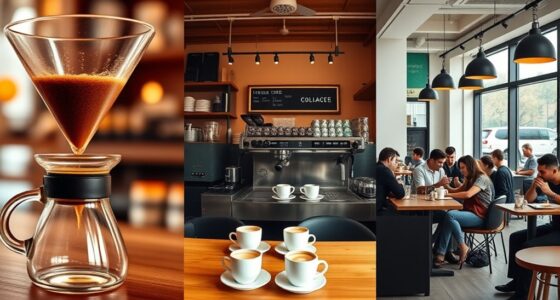During the Industrial Revolution, coffee played a crucial role in energizing the modern workforce. It helped workers stay alert during long factory shifts, boosting productivity and efficiency. Coffeehouses became lively hubs for exchanging ideas, fostering social bonds, and promoting social mobility. This increased productivity supported economic growth and urbanization, shaping new social dynamics. If you want to explore how these changes laid the foundation for today’s workforce, there’s more to discover below.
Key Takeaways
- Coffee boosted worker alertness and productivity, enabling longer shifts and faster factory operations during the Industrial Revolution.
- Coffeehouses served as social hubs, encouraging idea exchange and networking among workers, artisans, and intellectuals.
- Increased labor efficiency from coffee consumption contributed to economic growth and urbanization.
- Coffee facilitated social mobility and community building by connecting different social classes outside industrial settings.
- The energizing effects of coffee supported modern labor practices and fostered societal progress during industrialization.

The Industrial Revolution transformed society in many ways, and coffee played a surprisingly important role in fueling this change. As factories sprouted and cities expanded, workers needed a reliable way to stay alert and productive during long shifts. Coffee became more than just a morning pick-me-up; it turned into a essential tool for increasing labor productivity. With a cup in hand, you could maintain focus through the demanding hours, boosting efficiency and output. This caffeine-fueled energy helped factories operate at a faster pace, directly contributing to the rapid growth and success of industrial enterprises. As a result, coffee’s popularity surged among the working class, becoming a staple in workplaces and social hubs alike.
Coffee fueled industrial growth by boosting worker productivity and fostering social connections during the Industrial Revolution.
This shift in consumption patterns didn’t just impact individual workers—it also fostered significant social change. Coffeehouses emerged as lively centers of conversation, ideas, and networking, shaping the social fabric of the time. They became spaces where ideas about politics, economics, and innovation circulated freely, influencing public opinion and inspiring new ways of thinking. You might have found yourself in a bustling coffeehouse, exchanging thoughts with other workers, artisans, or intellectuals, all over a steaming cup. These social interactions contributed to a more connected and informed workforce, breaking down traditional barriers of class and status, and promoting social mobility. Lesser-known spots provided tranquil environments for reflection and community-building outside the hustle of industrial centers.
Moreover, the increased labor productivity driven by coffee meant that industries could operate more efficiently, leading to economic growth and urbanization. As workers became more alert and engaged, factories produced more goods at a faster rate, fueling the expansion of markets and trade. This, in turn, prompted societal shifts, such as the rise of a middle class and improved standards of living for many. Coffee’s role extended beyond individual alertness; it became a catalyst for social mobility and economic development. You might have noticed how coffeehouses became gathering spots for entrepreneurs, inventors, and workers, all sharing ideas that spurred innovation and progress.
In essence, coffee’s influence during the Industrial Revolution went far beyond its stimulating effects. It helped shape modern labor practices, encouraged social interaction, and supported the economic transformations that defined the era. By energizing workers and fostering social change, coffee laid the groundwork for a more interconnected and industrious society—one that would continue to evolve into the modern world we know today.
Frequently Asked Questions
How Did Coffee Influence Labor Productivity During the Industrial Revolution?
During the Industrial Revolution, coffee boosted labor productivity by increasing worker efficiency. You might find that caffeine dependence helped you stay alert and focused during long shifts, making your work more effective. Coffee’s energizing effects meant you could work longer hours without losing concentration. As a result, the widespread consumption of coffee played a vital role in supporting the demands of industrial labor, enhancing overall productivity and helping industries thrive.
What Role Did Coffeehouses Play in Worker Socialization and Information Exchange?
Did you know that nearly 80% of social networks in 18th-century cities formed in coffeehouses? These venues became essential for community building, where you could exchange news, ideas, and gossip. Coffeehouses fostered informal conversations that strengthened social bonds and spread information quickly. As a result, they played a pivotal role in worker socialization, creating hubs for communication that helped shape public opinion and connect communities in vibrant, lively spaces.
Were There Any Health Impacts of Increased Coffee Consumption on Industrial Workers?
You might notice that increased coffee consumption had mixed health effects on industrial workers. While caffeine boosted alertness and productivity, it also led to health concerns like caffeine dependence, causing withdrawal symptoms and sleep disturbances. Some workers experienced increased heart rates or stomach issues. Overall, the health impacts varied, but caffeine dependence was a significant concern, highlighting how reliance on coffee affected workers’ well-being during the Industrial Revolution.
How Did the Availability of Coffee Affect Shift Work and Factory Hours?
Imagine a torch illuminating factory floors—coffee consumption became that spark. With increased availability, you find factory schedules stretching longer, fueled by coffee’s energizing power. It allowed workers to stay alert during long shifts, making night work feasible. Coffee transformed shift work by enabling extended hours, helping industries boost productivity. Its widespread availability became the backbone of factory schedules, keeping the industrial engine running smoothly into the night.
Did Coffee Trade Impact Colonial Economies During the Industrial Revolution?
You might wonder if coffee trade impacted colonial economies during the Industrial Revolution. It did, as it strengthened trade routes between colonies and Europe, boosting colonial economies considerably. Coffee exports became a essential source of income, encouraging investments and expanding plantations. This trade helped colonial powers grow wealth and influence, shaping global commerce. So, coffee trade played a key role in fueling the economic development of colonies during that era.
Conclusion
As you reflect on how coffee fueled the Industrial Revolution, it’s almost surprising how a simple beverage became the catalyst for modern productivity. Coincidentally, as factories expanded and work hours lengthened, coffee’s energizing effects kept the workforce moving forward. Perhaps it’s no accident that this beverage, born in distant lands, played such a pivotal role in shaping the world’s economic and social landscape—proof that small beginnings can lead to extraordinary change.









